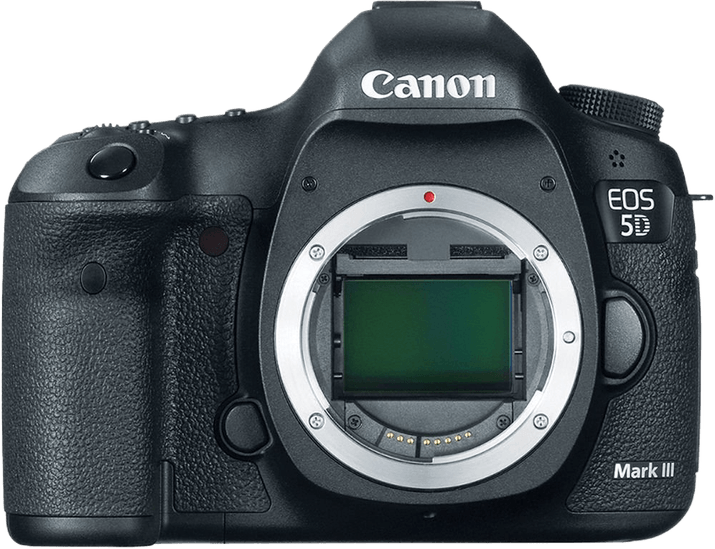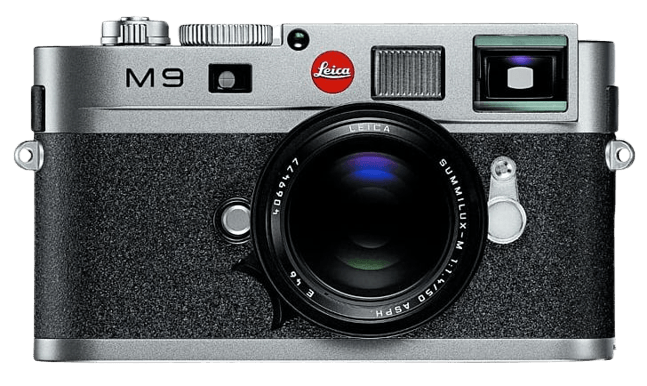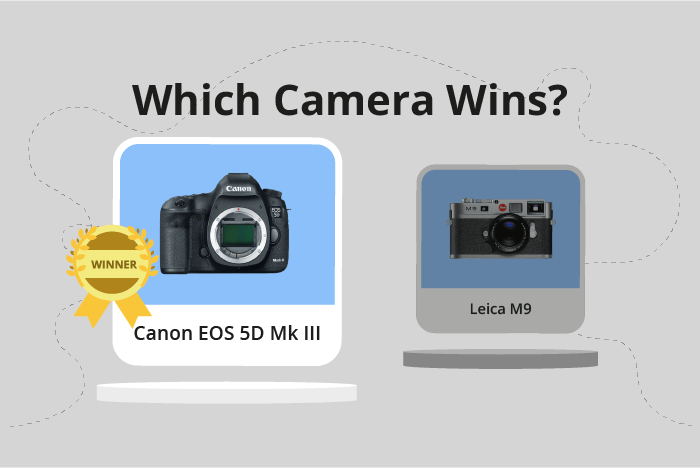Canon EOS 5D Mark III vs Leica M9 Comparison
Canon EOS 5D Mark III

Leica M9

The Canon EOS 5D Mark III triumphs over the Leica M9 with a score of 65/100 compared to the M9’s 34/100. Both cameras share some general specifications, such as being released in the early 2010s, with the 5D Mark III in 2012 and the M9 in 2009. They also have similar launch prices, with the 5D Mark III at $3,499 and the M9 at $5,500.
The 5D Mark III, a DSLR camera, excels in various aspects. It boasts a larger size (152 x 116 x 76mm) and a heavier weight (950g) compared to the M9’s smaller size (139 x 80 x 37mm) and lighter weight (585g). This difference in size and weight contributes to the 5D Mark III’s sturdiness and durability.
On the other hand, the Leica M9, a mirrorless camera, has its advantages. Its compact size and lighter weight make it a more portable option for photographers on the go. However, the lower score indicates that the M9 may not perform as well as the 5D Mark III in other aspects.
Taking into consideration the scores and specifications, the Canon EOS 5D Mark III proves to be a superior choice for those seeking a robust and high-performing camera, while the Leica M9 may be more suitable for photographers prioritizing portability.
Canon EOS 5D Mark III vs Leica M9 Overview and Optics
The Canon EOS 5D Mark III outperforms the Leica M9 in terms of optics, scoring 67/100 compared to the M9’s 42/100. Both cameras share some common specifications, including full-frame sensor size, lens mounts specific to their respective brands (Canon EF and Leica M), and the absence of image stabilization.
The 5D Mark III’s superiority in optics is evident in several aspects. First, it has a higher megapixel count of 22.3 compared to the M9’s 18, allowing for more detailed images. Second, the 5D Mark III has a faster shooting speed of 6 frames per second, whereas the M9 only manages 2 frames per second. This makes the 5D Mark III more suitable for capturing fast-moving subjects. Third, the 5D Mark III uses a CMOS sensor and a Digic 5+ processor, resulting in a higher DXOMARK score of 81 for its sensor compared to the M9’s CCD sensor and Maestro II processor, which score 69.
On the other hand, the Leica M9 has its own unique advantage in terms of optics. Its Leica M lens mount is compatible with a range of high-quality, renowned Leica lenses, which are known for their sharpness and color rendition. This can potentially provide better image quality despite the lower megapixel count and sensor score.
While both cameras possess strengths in their optics, the Canon EOS 5D Mark III clearly excels in multiple aspects and is the better choice for those prioritizing image resolution, shooting speed, and sensor performance. However, photographers who value the unique characteristics of Leica lenses may still find the Leica M9 to be a suitable option.
Canon EOS 5D Mark III vs Leica M9 Video Performance
When comparing the video capabilities of the Canon EOS 5D Mark III and the Leica M9, it is important to note that the Leica M9 does not have any video functionality. This means that if video recording is a crucial feature for a user, the Canon EOS 5D Mark III is the only option between these two cameras.
The Canon EOS 5D Mark III has a video score of 56 out of 100. This camera offers Full HD video recording with a maximum resolution of 1920 x 1080 pixels. Users can capture video at a maximum frame rate of 60 frames per second (fps), which can provide smooth motion in videos. However, the Canon EOS 5D Mark III does not have built-in time-lapse functionality, which could be a drawback for some users.
Taking into account the video capabilities of both cameras, it is clear that the Canon EOS 5D Mark III is the better option for those who require video recording capabilities. The Leica M9, lacking video functionality entirely, is not suitable for users who need to capture video content.
Canon EOS 5D Mark III vs Leica M9 Features and Benefits
The Canon EOS 5D Mark III wins in the features comparison with a score of 59 out of 100, while the Leica M9 scores only 17 out of 100. Both cameras share some common specifications, such as the absence of a touchscreen, flip screen, GPS, WIFI, and Bluetooth capabilities.
The Canon EOS 5D Mark III surpasses the Leica M9 in two significant areas: screen size and screen resolution. The 5D Mark III has a larger 3.2-inch screen, which provides better visibility and image review compared to the M9’s smaller 2.5-inch screen. The screen resolution of the 5D Mark III is also notably higher at 1,040,000 dots, allowing for a clearer and more detailed image display, while the M9 has a lower resolution of 230,000 dots.
The Leica M9 does not have any distinct advantages over the Canon EOS 5D Mark III in terms of features. Both cameras lack certain modern features that could enhance the user experience, such as touchscreens or WIFI connectivity.
Considering the features of both cameras, the Canon EOS 5D Mark III is the superior choice due to its larger screen size and higher resolution. This allows photographers to have a better experience when reviewing images and navigating the camera’s settings. The Leica M9 falls short in its feature offerings, providing no clear advantages over the 5D Mark III.
Canon EOS 5D Mark III vs Leica M9 Storage and Battery
The Canon EOS 5D Mark III outperforms the Leica M9 in storage and battery, scoring 76/100 compared to the Leica M9’s 21/100. Both cameras share some specifications, such as accepting SD and SDHC memory cards and lacking USB charging capabilities.
The Canon EOS 5D Mark III excels with its two memory card slots, compatibility with SDXC, Compact Flash, and UDMA cards, and an impressive battery life of 950 shots using the LP-E6 battery type. These features provide users with more storage options and extended shooting periods.
On the other hand, the Leica M9 has only one memory card slot and is limited to SD and SDHC cards. Its battery life is significantly lower, providing just 350 shots with the BP-SCL1 battery type. Despite these limitations, the Leica M9 still offers decent storage and battery performance for casual photography.
Considering these factors, the Canon EOS 5D Mark III offers superior storage and battery capabilities, making it a more suitable choice for professional photographers or those who require extended shooting periods and versatile storage options. The Leica M9 may be more appropriate for casual photography or users who do not need extensive battery life and storage flexibility.
Canon EOS 5D Mark III vs Leica M9 – Our Verdict
Are you still undecided about which camera is right for you? Have a look at these popular comparisons that feature the Canon EOS 5D Mark III or the Leica M9:

